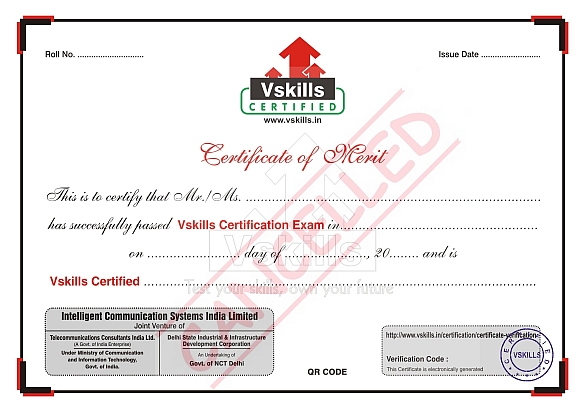- Duration / Course length: 1 To 2 Months Start now
- Certificates:
- Course delivery: This course is delivered in video format
Course details
Vskills certification for Merchandiser assesses the candidate as per the company’s need for merchandising of their products in retail stores. The certification tests the candidates on various areas in includes fashion merchandising, visual merchandising, design principles, color theory, consumer behavior, pricing, packaging, market segmentation, distribution, vendor management, import and export.Why should one take this certification?
This Course is intended for professionals and graduates wanting to excel in their chosen areas. It is also well suited for those who are already working and would like to take certification for further career progression.
Earning Vskills Merchandiser Certification can help candidate differentiate in today's competitive job market, broaden their employment opportunities by displaying their advanced skills, and result in higher earning potential.
Who will benefit from taking this certification?
Job seekers looking to find employment in merchandising or retail departments of various companies, students generally wanting to improve their skill set and make their CV stronger and existing employees looking for a better role can prove their employers the value of their skills through this certification.
Companies that hire Vskills Merchandiser
Merchandiser are in great demand. Companies specializing in merchandising or retail are constantly hiring skilled Merchandising Professionals. Various public and private companies also need merchandising professionals for their merchandising or retail departments.
Table of Contents
;Fashion Merchandising
- Introduction
- Merchandise Department
- Qualities of a Successful Buyer
- Buyer Rights
- Qualities of a Successful Buyer
- Forecasting fashion trends
- Market Reports
- History
- Window Display
- Shelves in the Clothes
- Cross-Mix Merchandising
- Props
- Colour
- Lighting
- Graphics & Signage
- Shop Interior
- Senses Seduction
- Stocking Basics
- Repetition
- Design Elements
- Principles of Design
- Historical Background
- Color Abstractions
- Complementary Colors
- Warm vs. cool colors
- Achromatic Colors
- Tints and shades
- Split Primary Colors
- Color Harmony
- Current Status
- Basic Techniques for Creating Color Schemes
- Types of Retail Outlets
- Retail Pricing
- Second-Hand Retail
- Black Box Model
- Information search
- Evaluation of Alternatives
- Purchase Decision
- Other Influences
- Buyer Decision Processes
- Purpose
- Packaging Types
- Symbols Used
- Label
- Specialized Labels
- Label Stock Types
- Label Attachment
- Influencing Attributes
- Pricing Approach and Strategies
- Cost Sheet Analysis
- Fashion
- Fashion Industry
- Social Media and Fashion Industry
- Advertising through Apps
- Successful Campaigns
- Category Management
- Quick Response Method
- Supply Chain, Vendor Relationships and Internal Relationships
- Design Lawsuits and Legislation
- Target Markets
- The Psychology of Target Marketing
- Benefits of Mass Marketing
- Criteria for Segmenting
- Methods for Segmenting Consumer Markets
- Psychographic
- Supplier Segmentation
- Positioning Strategies
- Product Management
- Goals and Change
- Types of style
- Physical Distribution, Marketing Logistics, and Supply Chain Management
- The Physical Distribution Concept
- Supply Chain Management (SCM)
- Materials Management
- Order Processing
- Inventory Management
- Production Control and Materials Requirement Planning
- Just-in-Time (JIT) Logistics Systems
- System of Vendor Evaluation
- Parameters for evaluation of Vendors Performance
- Social Audit
- Total Evaluation
- Guidelines for Purchases through Tender and Negotiations
- Purchase Review
- Export
- Ways of exporting
- Making the export decision
- Import
- Export Documentation
- Incoterms





